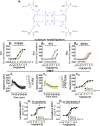Pharmacology of Kappa Opioid Receptors: Novel Assays and Ligands
- PMID: 35529436
- PMCID: PMC9068900
- DOI: 10.3389/fphar.2022.873082
Pharmacology of Kappa Opioid Receptors: Novel Assays and Ligands
Abstract
The present study investigated the in vitro pharmacology of the human kappa opioid receptor using multiple assays, including calcium mobilization in cells expressing chimeric G proteins, the dynamic mass redistribution (DMR) label-free assay, and a bioluminescence resonance energy transfer (BRET) assay that allows measurement of receptor interaction with G protein and β-arrestin 2. In all assays, dynorphin A, U-69,593, and [D-Pro10]dyn(1-11)-NH2 behaved as full agonists with the following rank order of potency [D-Pro10]dyn(1-11)-NH2 > dynorphin A ≥ U-69,593. [Dmt1,Tic2]dyn(1-11)-NH2 behaved as a moderate potency pure antagonist in the kappa-β-arrestin 2 interaction assay and as low efficacy partial agonist in the other assays. Norbinaltorphimine acted as a highly potent and pure antagonist in all assays except kappa-G protein interaction, where it displayed efficacy as an inverse agonist. The pharmacological actions of novel kappa ligands, namely the dynorphin A tetrameric derivative PWT2-Dyn A and the palmitoylated derivative Dyn A-palmitic, were also investigated. PWT2-Dyn A and Dyn A-palmitic mimicked dynorphin A effects in all assays showing similar maximal effects but 3-10 fold lower potency. In conclusion, in the present study, multiple in vitro assays for the kappa receptor have been set up and pharmacologically validated. In addition, PWT2-Dyn A and Dyn A-palmitic were characterized as potent full agonists; these compounds are worthy of further investigation in vivo for those conditions in which the activation of the kappa opioid receptor elicits beneficial effects e.g. pain and pruritus.
Keywords: BRET; G protein-coupled receptor; PWT2-dyn A; biased agonism; calcium mobilization; dyn A-palmitic; kappa opioid receptor; label-free.
Copyright © 2022 Sturaro, Malfacini, Argentieri, Djeujo, Marzola, Albanese, Ruzza, Guerrini, Calo’ and Molinari.
Conflict of interest statement
The authors declare that the research was conducted in the absence of any commercial or financial relationships that could be construed as a potential conflict of interest.
Figures






Similar articles
-
Design and synthesis of highly potent and selective cyclic dynorphin A analogs. 2. New analogs.J Med Chem. 1993 Mar 19;36(6):750-7. doi: 10.1021/jm00058a012. J Med Chem. 1993. PMID: 8096246
-
Effects of modifications of residues in position 3 of dynorphin A(1-11)-NH2 on kappa receptor selectivity and potency.J Med Chem. 1996 Jun 21;39(13):2456-60. doi: 10.1021/jm950655o. J Med Chem. 1996. PMID: 8691442
-
[2',6'-Dimethyltyrosine]dynorphin A(1-11)-NH2 analogues lacking an N-terminal amino group: potent and selective kappa opioid antagonists.J Med Chem. 2001 Sep 13;44(19):3048-53. doi: 10.1021/jm0101186. J Med Chem. 2001. PMID: 11543672
-
Role of the Dynorphin/Kappa Opioid Receptor System in the Motivational Effects of Ethanol.Alcohol Clin Exp Res. 2017 Aug;41(8):1402-1418. doi: 10.1111/acer.13406. Epub 2017 Jun 5. Alcohol Clin Exp Res. 2017. PMID: 28425121 Free PMC article. Review.
-
Dynorphin/Kappa-Opioid Receptor System Modulation of Cortical Circuitry.Handb Exp Pharmacol. 2022;271:223-253. doi: 10.1007/164_2021_440. Handb Exp Pharmacol. 2022. PMID: 33580392 Review.
Cited by
-
In vitro pharmacological characterization of standard and new lysophosphatidic acid receptor antagonists using dynamic mass redistribution assay.Front Pharmacol. 2023 Nov 14;14:1267414. doi: 10.3389/fphar.2023.1267414. eCollection 2023. Front Pharmacol. 2023. PMID: 38035009 Free PMC article.
-
A Comprehensive Analysis of Fibromyalgia and the Role of the Endogenous Opioid System.Biomedicines. 2025 Jan 11;13(1):165. doi: 10.3390/biomedicines13010165. Biomedicines. 2025. PMID: 39857749 Free PMC article. Review.
-
Functional selectivity of EM-2 analogs at the mu-opioid receptor.Front Pharmacol. 2023 Feb 24;14:1133961. doi: 10.3389/fphar.2023.1133961. eCollection 2023. Front Pharmacol. 2023. PMID: 36909169 Free PMC article.
-
Decoding the κ Opioid Receptor (KOR): Advancements in Structural Understanding and Implications for Opioid Analgesic Development.Molecules. 2024 Jun 3;29(11):2635. doi: 10.3390/molecules29112635. Molecules. 2024. PMID: 38893511 Free PMC article. Review.
References
LinkOut - more resources
Full Text Sources

